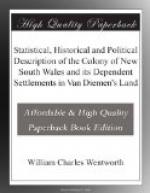“The feasting then commenced, and the governor retired amidst the long and reiterated acclamations and shouts of his sable and grateful congress. The number of the visitants, (exclusive of the fifteen children) amounted to one hundred and seventy-nine, viz. one hundred and five men, fifty-three women, and twenty-one children. It is worthy of observation that three of the latter mentioned number of children, (and the son of the memorable Bemni-long, was one of them) were placed in the native institution, immediately after the breaking up of the congress, on Saturday last, making the number of children now in that establishment, altogether eighteen; and we may reasonably trust that in a few years this benevolent institution will amply reward the hopes and expectations of its liberal patrons and supporters, and answer the grand object intended, by providing a seminary for the helpless off-spring of the natives of this country, and opening the path to their future civilization and improvement.”
Windsor.
The town of Windsor, (or as it was formerly called, the Green Hills), is thirty-five miles distant from Sydney, and is situated near the confluence of the South Creek with the river Hawkesbury. It stands on a hill, whose elevation is about one hundred feet above the level of the river, at low water. The buildings here are much of the same cast as at Parramatta, being in general weather boarded without, and lathed and plastered within.
The public buildings are a church, government house, hospital, barracks, court-house, store-house, and gaol, none of which are worthy of notice. The inn lately established by Mr. Fitzgerald, is by far the best building in the town, and may be pronounced upon the whole, the most splendid establishment of the kind in the colony.
The bulk of the population is composed of settlers, who have farms in the neighbourhood, and of their servants. There are besides a few inferior traders, publicans and artificers. The town contains in the whole about six hundred souls.
The Hawkesbury here is of considerable size, and navigable for vessels of one hundred tons burden, for about four miles above the town. A little higher up, it is joined by, or rather is called the Nepean river, and has several shallows; but with the help of two or three ferries, it might still be rendered navigable for boats of twelve or fifteen tons burden, for about twenty miles further. This substitution of water for land carriage, would be of great advantage to the numerous settlers who inhabit its highly fertile banks, and would also considerably promote the extension of agriculture throughout the adjacent districts.
Following the sinuosities of the river the distance of Windsor from the sea is about one hundred and forty miles; whereas in a straight line it is not more than thirty-five. The rise of the tide is about four feet, and the water is fresh for forty miles below the town.




